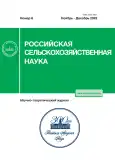Methodology of operational monitoring of crop status based on the internet of things technologies
- Authors: Savin I.Y.1,2, Blokhin Y.I.3, Chinilin A.V.4
-
Affiliations:
- Federal Research Center «Dokuchaev Soil Science Institute»
- Peoples’ Friendship University of Russia
- Agrophysical Research Institute
- Federal Research Center �Dokuchaev Soil Science Institute�
- Issue: No 6 (2023)
- Pages: 43-46
- Section: Articles
- URL: https://journals.rcsi.science/2500-2627/article/view/233875
- DOI: https://doi.org/10.31857/S2500262723060091
- EDN: https://elibrary.ru/NIBVVQ
- ID: 233875
Cite item
Full Text
Abstract
About the authors
I. Yu. Savin
Federal Research Center «Dokuchaev Soil Science Institute»;Peoples’ Friendship University of Russia
Email: savin_iyu@esoil.ru
119017, Moskva, Pyzhevskii per., 7, str. 2b;117198, Moskva, ul. Miklukho-Maklaya, 6
Yu. I. Blokhin
Agrophysical Research Institute195220, St. Petersburg, Grazhdansky pr., 14
A. V. Chinilin
Federal Research Center �Dokuchaev Soil Science Institute�119017, Moskva, Pyzhevskii per., 7, str. 2b
References
- Soma T., Nuckchady B. Communicating the Benefits and Risks of Digital Agriculture Technologies: Perspectives on the Future of Digital Agricultural Education and Training // Front. Commun. 2021. 6:762201. URL: https://www.frontiersin.org/articles/10.3389/fcomm.2021.762201/full (дата обращения: 27.07.2023). doi: 10.3389/fcomm.2021.762201.
- Priorities for Science to Overcome Hurdles Thwarting the Full Promise of the 'digital Agriculture' Revolution / M. Shepherd, J. A. Turner, B. Small, et al. // J. Sci. Food Agric. 2020. Vol. 100. No. 14. P. 5083-5092. doi: 10.1002/jsfa.9346.
- Цифровое земледелие / А. Л. Иванов, И. С. Козубенко, И. Ю. Савин и др. // Вестник российской сельскохозяйственной науки. 2018. № 5. С. 4-9.
- Van der Burg S., Bogaardt M.-J., Wolfert S. Ethics of Smart Farming: Current Questions and Directions for Responsible Innovation towards the Future // NJAS - Wageningen J. Life Sci. 2019. 90-91, 100289. URL: https://www.tandfonline.com/doi/full/10.1016/j.njas.2019.01.001 (дата обращения: 27.07.2023). doi: 10.1016/j.njas.2019.01.001.
- Sung J. The Fourth Industrial Revolution and Precision Agriculture // InTech. 2018. URL: https://www.intechopen.com/chapters/57703 (дата обращения: 27.07.2023). doi: 10.5772/intechopen.71582.
- Точное земледелие как один из аспектов цифровизации сельского хозяйства / С. В. Шайтура, А. В. Коломейцев, И. И. Позняк и др. // Вестник Курской государственной сельскохозяйственной академии. 2022. № 3. С. 161-166.
- Tendulkar A. Introduction to Precision Agriculture: Overview, Concepts, World Interest, Policy, and Economics // Precision Agriculture Technologies for Food Security and Sustainability/ edited by Sherine M. Abd El-Kader and Basma M. Mohammad El-Basioni, IGI Global, 2021. P. 1-22. URL: https://www.researchgate.net/publication/348122259_Introduction_to_Precision_Agriculture_Overview_Concepts_World_Interest_Policy_and_Economics (дата обращения: 27.07.2023). doi: 10.4018/978-1-7998-5000-7.ch001.
- Якушев В. В. Точное земледелие: теория и практика. СПб.: ФГБНУ АФИ, 2016. 364 с.
- Савин И. Ю., Блохин Ю. И. Об оптимизации размещения сети сенсорных узлов БСС, включенных в интернет вещей на пахотных угодьях // Бюллетень Почвенного института имени В. В. Докучаева. 2022. № 110. С. 22-50. doi: 10.19047/0136-1694-2022-110-22-50.
- Monitoring Soil and Ambient Parameters in the IoT Precision Agriculture Scenario: An Original Modeling Approach Dedicated to Low-Cost Soil Water Content Sensors / P. Placidi, R. Morbidelli, D. Fortunati, et al. // Sensors. 2021. Vol. 21. P. 5110. URL: https://www.mdpi.com/1424-8220/21/15/5110 (дата обращения: 27.07.2023). doi: 10.3390/s21155110.
- Ravesa A., Shabir A. S. Precision agriculture using IoT data analytics and machine learning // Journal of King Saud University - Computer and Information Sciences. 2022. Vol. 34. No. 8. Part B. P. 5602-5618. doi: 10.1016/j.jksuci.2021.05.013.
- Современные решения для формирования опорной информации с целью повышения точности определения агрофизических свойств почвы по спутниковым данным / Ю. И. Блохин, В. В. Якушев, С. Ю. Блохина и др. // Современные проблемы дистанционного зондирования Земли из космоса. 2020. Т. 17. № 4. С. 164-178. doi: 10.21046/2070-7401-2020-17-4-164-178.
- State of Major Vegetation Indices in Precision Agriculture Studies Indexed in Web of Science: A Review / D. Radočaj, A. Šiljeg, R. Marinović, et al. // Agriculture. 2023.Vol. 13. No. 3. P. 707. URL: https://www.mdpi.com/2077-0472/13/3/707 (дата обращения: 27.07.2023). doi: 10.3390/agriculture13030707.
- Selective spraying of grapevines for disease control using a modular agricultural robot / Oberti R., Marchi M., Tirelli P., et al. // Biosyst. Eng. 2016. Vol. 146. P. 203-215. doi: 10.1016/j.biosystemseng.2015.12.004.
- Kim S., Lee M., Shin C. IoT-Based Strawberry Disease Prediction System for Smart Farming // Sensors. 2018. Vol. 18. No. 11. P. 4051. URL: https://www.mdpi.com/1424-8220/18/11/4051 (дата обращения: 27.07.2023). doi: 10.3390/s18114051.
- Internet of Things Platform for Smart Farming: Experiences and Lessons Learnt / P. P. Jayaraman, A. Yavari, D. Georgakopoulos, et al. // Sensors. 2016. Vol. 16. No. 11. P. 1884. URL: https://www.mdpi.com/1424-8220/16/11/1884 (дата обращения: 27.07.2023). doi: 10.3390/s16111884.
- Can the plant area index of a submerged vegetation canopy be estimated using digital hemispherical photography? / D. Zhao, M. Lv, P. Wang, et al. // Agricultural and Forest Meteorology. 2014. Vol. 192.P. 69-77.
- Methods for in situ leaf area index measurement, part II: from gap fraction to leaf area index: retrieval methods and sampling strategies / M. Weiss, F. Baret, G. J. Smith, et al. // Agric. For. Meteorol. 2004. Vol. 121. P. 17-53.
- Guo Y. Wearable sensors to monitor plant health // Nat. Food. 2023. Vol. 4. P. 350. URL: https://www.nature.com/articles/s43016-023-00764-3 (дата обращения: 27.07.2023). doi: 10.1038/s43016-023-00764-3.
Supplementary files









